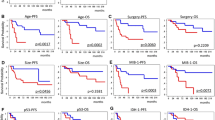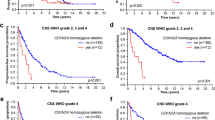Abstract
The impact of isocitrate dehydrogenase (IDH1/2) mutations on the malignant progression of gliomas was investigated by comparing the histopathological features of 53 grade II and III gliomas after recurrence according to the IDH1/2 status. We identified IDH1/2 mutations in 44.4 % (16 of 36) of astrocytic tumors and 70.6 % (12 of 17) of oligodendroglial tumors. Histopathological malignant progression was observed in 68.8 % (11 in 16) and 55 % (11 in 20) of astrocytic tumors with and without IDH1/2 mutations, respectively. There were 8 secondary glioblastomas (GBM) that had progressed from 5 diffuse astrocytomas (DA) and 3 anaplastic astrocytomas (AA) with IDH1/2 mutations. Seven secondary GBMs were derived from 3 DAs and 4 AAs with wild-type IDH1/2. Malignant progression was observed in 47.1 % (8 of 17) of oligodendroglial tumors. All 12 oligodendroglial tumors with IDH1/2 mutations remained as such without progressing to GBM, whereas 3 of the 5 oligodendroglial tumors without IDH1/2 mutations progressed to GBM at recurrence. In conclusion, grade II and III gliomas developed to more malignant histological types, irrespective of the IDH1/2 mutation status, and the monitoring of the IDH1/2 status could be of value to predict the development of GBM in patients with oligodendroglial tumors.


Similar content being viewed by others
References
Louis DN, Ohgaki H, Wiestler OD, Cavenee WK (2007) WHO classification of tumours of the central nervous system, 4th edn. International Agency for Research on Cancer (IARC), Lyon
Jeuken JW, Sprenger SH, Vermeer H et al (2002) Chromosomal imbalances in primary oligodendroglial tumors and their recurrences: clues about malignant progression detected using comparative genomic hybridization. J Neurosurg 96:559–564
Ohgaki H, Kleihues P (2011) Genetic profile of astrocytic and oligodendroglial gliomas. Brain Tumor Pathol 28:177–183
Miller CR, Dunham CP, Scheithauer BW, Perry A (2006) Significance of necrosis in grading of oligodendroglial neoplasms: a clinicopathologic and genetic study of newly diagnosed high-grade gliomas. J Clin Oncol 24:5419–5426
Balss J, Meyer J, Mueller W et al (2008) Analysis of the IDH1 codon 132 mutation in brain tumors. Acta Neuropathol 116:597–602
Hartmann C, Meyer J, Balss J et al (2009) Type and frequency of IDH1 and IDH2 mutations are related to astrocytic and oligodendroglial differentiation and age: a study of 1,010 diffuse gliomas. Acta Neuropathol 118:469–474
Ichimura K, Pearson DM, Kocialkowski S et al (2009) IDH1 mutations are present in the majority of common adult gliomas but rare in primary glioblastomas. Neuro Oncol 11:341–347
Watanabe T, Nobusawa S, Kleihues P, Ohgaki H (2009) IDH1 mutations are early events in the development of astrocytomas and oligodendrogliomas. Am J Pathol 174:1149–1153
Yan H, Parsons DW, Jin G et al (2009) IDH1 and IDH2 mutations in gliomas. N Engl J Med 360:765–773
Kim YH, Nobusawa S, Mittelbronn M et al (2010) Molecular classification of low-grade diffuse gliomas. Am J Pathol 177:2708–2714
Ichimura K. (2012) Molecular pathogenesis of IDH mutations in gliomas. Brain Tumor Pathol
Reitman ZJ, Yan H (2010) Isocitrate dehydrogenase 1 and 2 mutations in cancer: alterations at a crossroads of cellular metabolism. J Natl Cancer Inst 102:932–941
Capper D, Reuss D, Schittenhelm J et al (2011) Mutation-specific IDH1 antibody differentiates oligodendrogliomas and oligoastrocytomas from other brain tumors with oligodendroglioma-like morphology. Acta Neuropathol 121:241–252
Chaichana KL, McGirt MJ, Laterra J et al (2010) Recurrence and malignant degeneration after resection of adult hemispheric low-grade gliomas. J Neurosurg 112:10–17
Jaeckle KA, Decker PA, Ballman KV et al (2010) Transformation of low grade glioma and correlation with outcome: an NCCTG database analysis. J Neurooncol 104:253–259
Lavon I, Zrihan D, Zelikovitch B et al (2007) Longitudinal assessment of genetic and epigenetic markers in oligodendrogliomas. Clin Cancer Res 13:1429–1437
McCormack BM, Miller DC, Budzilovich GN et al (1992) Treatment and survival of low-grade astrocytoma in adults—1977–1988. Neurosurgery 31:636–642 discussion 642
Ohgaki H, Kleihues P (2005) Population-based studies on incidence, survival rates, and genetic alterations in astrocytic and oligodendroglial gliomas. J Neuropathol Exp Neurol 64:479–489
Schmidt MH, Berger MS, Lamborn KR et al (2003) Repeated operations for infiltrative low-grade gliomas without intervening therapy. J Neurosurg 98:1165–1169
van den Bent MJ, Afra D, de Witte O et al (2005) Long-term efficacy of early versus delayed radiotherapy for low-grade astrocytoma and oligodendroglioma in adults: the EORTC 22845 randomised trial. Lancet 366:985–990
Kreth FW, Faist M, Rossner R et al (1997) Supratentorial World Health Organization Grade 2 astrocytomas and oligoastrocytomas. A new pattern of prognostic factors. Cancer 79:370–379
Berger MS, Deliganis AV, Dobbins J, Keles GE (1994) The effect of extent of resection on recurrence in patients with low grade cerebral hemisphere gliomas. Cancer 74:1784–1791
Claus EB, Horlacher A, Hsu L et al (2005) Survival rates in patients with low-grade glioma after intraoperative magnetic resonance image guidance. Cancer 103:1227–1233
Sanson M, Marie Y, Paris S et al (2009) Isocitrate dehydrogenase 1 codon 132 mutation is an important prognostic biomarker in gliomas. J Clin Oncol 27:4150–4154
Coons SW, Johnson PC, Scheithauer BW et al (1997) Improving diagnostic accuracy and interobserver concordance in the classification and grading of primary gliomas. Cancer 79:1381–1393
Labussiere M, Idbaih A, Wang XW et al (2010) All the 1p19q codeleted gliomas are mutated on IDH1 or IDH2. Neurology 74:1886–1890
Giannini C, Burger PC, Berkey BA et al (2008) Anaplastic oligodendroglial tumors: refining the correlation among histopathology, 1p 19q deletion and clinical outcome in Intergroup Radiation Therapy Oncology Group Trial 9402. Brain Pathol 18:360–369
Acknowledgments
This work was supported in part by the National Cancer Center Research and Development Fund (H22-55).
Author information
Authors and Affiliations
Corresponding author
Rights and permissions
About this article
Cite this article
Ohno, M., Narita, Y., Miyakita, Y. et al. Histopathological malignant progression of grade II and III gliomas correlated with IDH1/2 mutation status. Brain Tumor Pathol 29, 183–191 (2012). https://doi.org/10.1007/s10014-012-0113-1
Received:
Accepted:
Published:
Issue Date:
DOI: https://doi.org/10.1007/s10014-012-0113-1




